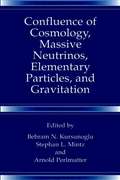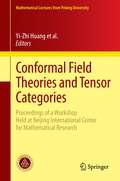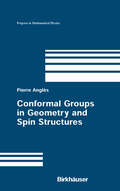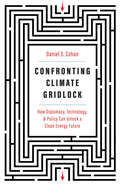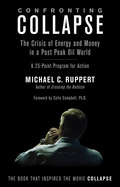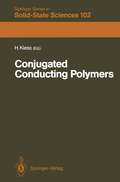- Table View
- List View
Conflicts Between Biodiversity Conservation and Humans: The Case of the Chihuahua Desert and Cuatro Ciénegas (Cuatro Ciénegas Basin: An Endangered Hyperdiverse Oasis)
by Valeria Souza Luis E. Eguiarte Irene Pisanty María C. MandujanoThis book takes readers on a journey through the history of water in the Coahuila desert. It starts by describing the beauty and mysteries of the landscape, and then explores the rock art of the original desert cultures in Coahuila, offering readers a glimpse of the sacred nature of water in the desert, as well as the rituals surrounding it. Moving on to the colonial times and the post- independence development of the region, it discusses early water management, and explores how water is managed in modern times, as well as the legal complications of the law, and how these faulty laws, designed for less arid regions, have affected a highly diverse wetland, the Cuatro Ciénegas oasis. The book then examines the biological consequences of the water loss for the aquatic plants and animals in Churince – a now extinct system within Cuatro Ciénegas. Further, it addresses how even bacteria can become extinct in this hyper-diverse microbial oasis. Lastly, after this despair and sense of loss, the book provides hope, offering suggestions for how we can transform the future, from a social and educational point of view as well as through good science and changes in policy.
Conflicts over Natural Resources in the Global South: Conceptual Approaches
by Maarten Bavinck Lorenzo Pellegrini Erik MostertInhabitants of poor, rural areas in the Global South heavily depend on natural resources in their immediate vicinity. Conflicts over and exploitation of these resources � whether it is water, fish, wood fuel, minerals, or land � severely affect their livelihoods. The contributors to this volume leave behind the polarised debate, previously surround
Confluence of Cosmology, Massive Neutrinos, Elementary Particles, and Gravitation
by Behram N. Kursunogammalu Stephan L. Mintz Arnold PerlmutterJustbefore the preliminary programof Orbis Scientiae 1998 went to press the news in physics was suddenly dominated by the discovery that neutrinos are, after all, massive particles. This was predicted by some physicists including Dr. Behram Kusunoglu, who had apaper published on this subject in 1976 in the Physical Review. Massive neutrinos do not necessarily simplify the physics of elementary particles but they do give elementary particle physics a new direction. If the dark matter content ofthe universe turns out to consist ofneutrinos, the fact that they are massive should make an impact on cosmology. Some of the papers in this volume have attempted to provide answers to these questions. We have a long way to go before we find the real reasons for nature’s creation of neutrinos. Another neutrino-related event was the passing of their discoverer, Fredrick Reines: The trustees of the Global Foundation, members of the Orbis Scientiae 1998, dedicate this conference to Fredrick Reines of the University of California at Irvine. The late Professor Reines was a loyal and active member of these series of conferences on the frontiers of physics and cosmology since 1964. He also sewed as one of the trustees of the Global Foundation for the past three years. Professor Reines discovered the most elusive particle, the neutrino, in 1954. We are proud to say that we recognized the importance of this discovery by awarding him the J.
Confocal Raman Microscopy (Springer Series in Surface Sciences #66)
by Jan Toporski Thomas Dieing Olaf HollricherThis second edition provides a cutting-edge overview of physical, technical and scientific aspects related to the widely used analytical method of confocal Raman microscopy. The book includes expanded background information and adds insights into how confocal Raman microscopy, especially 3D Raman imaging, can be integrated with other methods to produce a variety of correlative microscopy combinations. The benefits are then demonstrated and supported by numerous examples from the fields of materials science, 2D materials, the life sciences, pharmaceutical research and development, as well as the geosciences.
Conformal Field Theories and Tensor Categories: Proceedings of a Workshop Held at Beijing International Center for Mathematical Research (Mathematical Lectures from Peking University)
by Chengming Bai Jürgen Fuchs Yi-Zhi Huang Liang Kong Ingo Runkel Christoph SchweigertThe present volume is a collection of seven papers that are either based on the talks presented at the workshop "Conformal field theories and tensor categories" held June 13 to June 17, 2011 at theBeijing International Center for Mathematical Research, Peking University, or are extensions of the material presented in the talks at the workshop. These papers present new developments beyond rational conformal field theories and modular tensor categories and new applications in mathematics and physics. The topics covered include tensor categories from representation categories of Hopf algebras, applications of conformal field theories and tensor categories to topological phases and gapped systems, logarithmic conformal field theories and the corresponding non-semisimple tensor categories, and new developments in the representation theory of vertex operator algebras. Some of the papers contain detailed introductory material that is helpful for graduate students and researchers looking for an introduction to these research directions. The papers also discuss exciting recent developments in the area of conformal field theories, tensor categories and their applications and will be extremely useful for researchers working in these areas.
Conformal Field Theory (Graduate Texts in Contemporary Physics)
by Philippe Francesco Pierre Mathieu David SenechalFilling an important gap in the literature, this comprehensive text develops conformal field theory from first principles. The treatment is self-contained, pedagogical, and exhaustive, and includes a great deal of background material on quantum field theory, statistical mechanics, Lie algebras and affine Lie algebras. The many exercises, with a wide spectrum of difficulty and subjects, complement and in many cases extend the text. The text is thus not only an excellent tool for classroom teaching but also for individual study. Intended primarily for graduate students and researchers in theoretical high-energy physics, mathematical physics, condensed matter theory, statistical physics, the book will also be of interest in other areas of theoretical physics and mathematics. It will prepare the reader for original research in this very active field of theoretical and mathematical physics.
Conformal Field Theory, Automorphic Forms and Related Topics: CFT, Heidelberg, September 19-23, 2011 (Contributions in Mathematical and Computational Sciences #8)
by Winfried Kohnen Rainer WeissauerThis book, part of the series Contributions in Mathematical and Computational Sciences, reviews recent developments in the theory of vertex operator algebras (VOAs) and their applications to mathematics and physics.The mathematical theory of VOAs originated from the famous monstrous moonshine conjectures of J.H. Conway and S.P. Norton, which predicted a deep relationship between the characters of the largest simple finite sporadic group, the Monster and the theory of modular forms inspired by the observations of J. MacKay and J. Thompson.The contributions are based on lectures delivered at the 2011 conference on Conformal Field Theory, Automorphic Forms and Related Topics, organized by the editors as part of a special program offered at Heidelberg University that summer under the sponsorship of the Mathematics Center Heidelberg (MATCH).
Conformal Field Theory for Particle Physicists: From QFT Axioms to the Modern Conformal Bootstrap (SpringerBriefs in Physics)
by Marc GilliozThis book is a set of introductory lecture notes on Conformal Field Theory (CFT). Unlike most existing reviews on the subject, CFT is presented here from the perspective of a unitary quantum field theory in Minkowski space-time. The book starts with a non-perturbative formulation of quantum field theory (Wightman axioms) and then, gradually, focuses on the implications of scale and special conformal symmetry, all the way to the modern conformal bootstrap. This approach includes topics such as subtleties of conformal transformations in Minkowski space-time, the construction of Wightman functions and time-ordered correlators both in position- and momentum-space, unitarity bounds derived from the spectral representation, and the appearance of UV and IR divergences. In each chapter, the reader finds useful exercises to master the subject. This book is meant for graduate students in theoretical physics and for more advanced researchers working in high-energy physics who are not necessarily familiar with the concepts of conformal field theory. Prior knowledge of quantum field theory is needed to master the arguments.
Conformal Groups in Geometry and Spin Structures (Progress in Mathematical Physics #50)
by Pierre AnglèsThis book provides a self-contained overview of the role of conformal groups in geometry and mathematical physics. It features a careful development of the material, from the basics of Clifford algebras to more advanced topics. Each chapter covers a specific aspect of conformal groups and conformal spin geometry. All major concepts are introduced and followed by detailed descriptions and definitions, and a comprehensive bibliography and index round out the work. Rich in exercises that are accompanied by full proofs and many hints, the book will be ideal as a course text or self-study volume for senior undergraduates and graduate students.
Conformal Invariance: an Introduction to Loops, Interfaces and Stochastic Loewner Evolution (Lecture Notes in Physics #853)
by Malte Henkel and Dragi KarevskiConformal invariance has been a spectacularly successful tool in advancing our understanding of the two-dimensional phase transitions found in classical systems at equilibrium. This volume sharpens our picture of the applications of conformal invariance, introducing non-local observables such as loops and interfaces before explaining how they arise in specific physical contexts. It then shows how to use conformal invariance to determine their properties. Moving on to cover key conceptual developments in conformal invariance, the book devotes much of its space to stochastic Loewner evolution (SLE), detailing SLE’s conceptual foundations as well as extensive numerical tests. The chapters then elucidate SLE’s use in geometric phase transitions such as percolation or polymer systems, paying particular attention to surface effects. As clear and accessible as it is authoritative, this publication is as suitable for non-specialist readers and graduate students alike.
Conformal Invariance and Critical Phenomena (Theoretical and Mathematical Physics)
by Malte HenkelCritical phenomena arise in a wide variety of physical systems. Classi cal examples are the liquid-vapour critical point or the paramagnetic ferromagnetic transition. Further examples include multicomponent fluids and alloys, superfluids, superconductors, polymers and fully developed tur bulence and may even extend to the quark-gluon plasma and the early uni verse as a whole. Early theoretical investigators tried to reduce the problem to a very small number of degrees of freedom, such as the van der Waals equation and mean field approximations, culminating in Landau's general theory of critical phenomena. Nowadays, it is understood that the common ground for all these phenomena lies in the presence of strong fluctuations of infinitely many coupled variables. This was made explicit first through the exact solution of the two-dimensional Ising model by Onsager. Systematic subsequent developments have been leading to the scaling theories of critical phenomena and the renormalization group which allow a precise description of the close neighborhood of the critical point, often in good agreement with experiments. In contrast to the general understanding a century ago, the presence of fluctuations on all length scales at a critical point is emphasized today. This can be briefly summarized by saying that at a critical point a system is scale invariant. In addition, conformal invaTiance permits also a non-uniform, local rescal ing, provided only that angles remain unchanged.
The Conformal Structure of Space-Times: Geometry, Analysis, Numerics (Lecture Notes in Physics #604)
by Jörg Frauendiener Helmut FriedrichCausal relations, and with them the underlying null cone or conformal structure, form a basic ingredient in all general analytical studies of asymptotically flat space-time. The present book reviews these aspects from the analytical, geometrical and numerical points of view. Care has been taken to present the material in a way that will also be accessible to postgraduate students and nonspecialist reseachers from related fields.
Conformal Symmetry Breaking Operators for Differential Forms on Spheres (Lecture Notes in Mathematics #2170)
by Toshiyuki Kobayashi Toshihisa Kubo Michael PevznerThis work is the first systematic study of all possible conformally covariant differential operators transforming differential forms on a Riemannian manifold X into those on a submanifold Y with focus on the model space (X, Y) = (Sn, Sn-1).The authors give a complete classification of all such conformally covariant differential operators, and find their explicit formulæ in the flat coordinates in terms of basic operators in differential geometry and classical hypergeometric polynomials. Resulting families of operators are natural generalizations of the Rankin–Cohen brackets for modular forms and Juhl's operators from conformal holography. The matrix-valued factorization identities among all possible combinations of conformally covariant differential operators are also established.The main machinery of the proof relies on the "F-method" recently introduced and developed by the authors. It is a general method to construct intertwining operators between C∞-induced representations or to find singular vectors of Verma modules in the context of branching rules, as solutions to differential equations on the Fourier transform side. The book gives a new extension of the F-method to the matrix-valued case in the general setting, which could be applied to other problems as well.This book offers a self-contained introduction to the analysis of symmetry breaking operators for infinite-dimensional representations of reductive Lie groups. This feature will be helpful for active scientists and accessible to graduate students and young researchers in differential geometry, representation theory, and theoretical physics.
Confronting Climate Change in Bangladesh: Policy Strategies for Adaptation and Resilience (The Anthropocene: Politik—Economics—Society—Science #28)
by Helena Wright Julia Taub Clare Stott Adrian Fenton Jeffrey Chow Saleemul HuqDue to its vulnerability to a wide variety of climate change impacts, Bangladesh has become a laboratory for adaptation and resilience strategies in the developing world. The knowledge shared by experienced practitioners who have a deep understanding of the complex context of this country is an invaluable resource. The International Centre for Climate Change and Development has brought together a host of experts across multiple disciplines to provide a detailed look at Bangladesh's ongoing struggle to prepare for the inevitable threats that climate change poses. This volume presents public policy-oriented strategies across numerous sectors, including agriculture, freshwater management, forests, finance, human rights, health systems, flood control, infrastructure, solar energy, and more. Successes and shortcomings both provide useful lessons for other countries grappling with similar climate threats. This book offers the latest research findings for a wider audience.- Showcasing the wealth of experience with adaptation and resilience in Bangladesh- Drawing from expert practitioners across the numerous sectors affected by climate change- Highlighting key lessons for other Least Developed Countries.
Confronting Climate Gridlock: How Diplomacy, Technology, and Policy Can Unlock a Clean Energy Future
by Daniel S CohanAn atmospheric scientist explains why global climate change mitigation and energy decarbonization demand American diplomacy, technology, and policy “Daniel Cohan makes a compelling case that the problem of climate change is solvable. Fixing the gridlock on global action requires fixing the gridlock here in the United States of America. Cohan shows how that can be done.”—David Victor, UC San Diego Professor of environmental engineering Daniel Cohan argues that escaping the gravest perils of climate change will first require American diplomacy, technological innovation, and policy to catalyze decarbonization globally. Combining his own expertise along with insights from more than a hundred interviews with diplomats, scholars, and clean-technology pioneers, Cohan identifies flaws in previous efforts to combat climate change. He highlights opportunities for more successful strategies, including international “climate clubs” and accelerated development of clean energy technologies. Grounded in history and emerging scholarship, this book offers a forward-looking vision of solutions to confronting climate gridlock and a clear-eyed recognition of the challenges to enacting them.
Confronting Collapse: The Crisis of Energy and Money in a Post Peak Oil World
by Michael C. Ruppert Colin CampbellThe book that inspired the movie Collapse. The world is running short of energy-especially cheap, easy-to-find oil. Shortages, along with resulting price increases, threaten industrialized civilization, the global economy, and our entire way of life. In Confronting Collapse, author Michael C. Ruppert, a former LAPD narcotics officer turned investigative journalist, details the intricate connections between money and energy, including the ways in which oil shortages and price spikes triggered the economic crash that began in September 2008. Given the 96 percent correlation between economic growth and greenhouse gas emissions and the unlikelihood of economic growth without a spike in energy use, Ruppert argues that we are not, in fact, on the verge of economic recovery, but on the verge of complete collapse. Ruppert's truth is not merely inconvenient. It is utterly devastating. But there is still hope. Ruppert outlines a 25-point plan of action, including the creation of a second strategic petroleum reserve for the use of state and local governments, the immediate implementation of a national Feed-in Tariff mandating that electric utilities pay 3 percent above market rates for all surplus electricity generated from renewable sources, a thorough assessment of soil conditions nationwide, and an emergency action plan for soil restoration and sustainable agriculture.
Confronting Hunger in the USA: Searching for Community Empowerment and Food Security in Food Access Programs (Critical Food Studies)
by Adam M. PineFood insecurity in the US is a critical issue that is experienced by approximately 15% of the population each year. Hunger is not caused by an inability to produce enough food for the population, but is instead a manifestation of federal agricultural policies that support the overproduction of commodity crops and neoliberal social policies that seek to lower the amount of benefits dispersed to those in need. This book focuses on how four different food-based community programs address both the physical sensation of hunger as well as the political and economic disempowerment that work against the ability of people experiencing food insecurity to mobilize as a political force. Confronting Hunger in the USA argues that most food programs do more to create community among their volunteers than among program participants and tend to reinforce neoliberal understandings of citizenship. Community food programs reach out to the most vulnerable members of society in caring and gentle ways and often use the language of alternative economies to articulate a different relationship between the individual and the state. However, the projects in this study act as individual pieces of the state's insufficient social safety net and are only beginning to articulate a new relationship between food and society.
Confronting Hunger in the USA: Searching for Community Empowerment and Food Security in Food Access Programs (Critical Food Studies)
by Adam M. PineFood insecurity in the US is a critical issue that is experienced by approximately 15% of the population each year. Hunger is not caused by an inability to produce enough food for the population, but is instead a manifestation of federal agricultural policies that support the overproduction of commodity crops and neoliberal social policies that seek to lower the amount of benefits dispersed to those in need. This book focuses on how four different food-based community programs address both the physical sensation of hunger as well as the political and economic disempowerment that work against the ability of people experiencing food insecurity to mobilize as a political force. Confronting Hunger in the USA argues that most food programs do more to create community among their volunteers than among program participants and tend to reinforce neoliberal understandings of citizenship. Community food programs reach out to the most vulnerable members of society in caring and gentle ways and often use the language of alternative economies to articulate a different relationship between the individual and the state. However, the projects in this study act as individual pieces of the state's insufficient social safety net and are only beginning to articulate a new relationship between food and society.
Confronting Land and Property Problems for Peace (Routledge Explorations in Development Studies)
by Shinichi TakeuchiThis collection clarifies the background of land and property problems in conflict-affected settings, and explores appropriate policy measures for peace-building. While land and property problems exist in any society, they can be particularly exacerbated in conflict-affected settings – characterized by unstable security, weak governance, loss of proper documentation as well as the return of refugees and Internally Displaced Persons. Unless these problems are properly addressed, they can destabilize fragile political order and hinder economic recovery. Although tackling land and property problems is an important challenge for peace-building, it has been relatively neglected in recent debates about liberal peace-building as a result of the strong focus on state-level institution building, such as security sector reforms and transitional justice. Using rich original data from eight conflict-affected countries, this book examines the topic from the viewpoint of State-society relationship. In contrast to previous literature, this volume analyses land and property problems in conflict-afflicted areas from a long-term perspective of state-building and economic development, rather than concentrating only on the immediate aftermath of the conflict. The long-term perspective enables not only an understanding of the root causes of the property problems in conflict-affected countries, but also elaboration of effective policy measures for peace. Contributors are area specialists and the eight case study countries have been carefully selected for comparative study. The collection applies a common framework to a diverse group of countries – South Sudan, Uganda, Rwanda, Burundi, Cambodia, Timor-Leste, Colombia, and Bosnia-Herzegovina.
Confronting Land and Property Problems for Peace (Routledge Explorations in Development Studies)
by Shinichi TakeuchiThis collection clarifies the background of land and property problems in conflict-affected settings, and explores appropriate policy measures for peace-building. While land and property problems exist in any society, they can be particularly exacerbated in conflict-affected settings – characterized by unstable security, weak governance, loss of proper documentation as well as the return of refugees and Internally Displaced Persons. Unless these problems are properly addressed, they can destabilize fragile political order and hinder economic recovery. Although tackling land and property problems is an important challenge for peace-building, it has been relatively neglected in recent debates about liberal peace-building as a result of the strong focus on state-level institution building, such as security sector reforms and transitional justice. Using rich original data from eight conflict-affected countries, this book examines the topic from the viewpoint of State-society relationship. In contrast to previous literature, this volume analyses land and property problems in conflict-afflicted areas from a long-term perspective of state-building and economic development, rather than concentrating only on the immediate aftermath of the conflict. The long-term perspective enables not only an understanding of the root causes of the property problems in conflict-affected countries, but also elaboration of effective policy measures for peace. Contributors are area specialists and the eight case study countries have been carefully selected for comparative study. The collection applies a common framework to a diverse group of countries – South Sudan, Uganda, Rwanda, Burundi, Cambodia, Timor-Leste, Colombia, and Bosnia-Herzegovina.
Congo Basin Hydrology, Climate, and Biogeochemistry: A Foundation for the Future (Geophysical Monograph Series)
by Raphael M. Tshimanga Guy D. Moukandi N'kaya Douglas AlsdorfNew scientific discoveries in the Congo Basin as a result of international collaborations The Congo is the world’s second largest river basin and home to 120 million people. Understanding the cycling of water, sediments, and nutrients is important as the region faces climatic and anthropogenic change. Congo Basin Hydrology, Climate, and Biogeochemistry: A Foundation for the Future explores variations in and influences on rainfall, hydrology and hydraulics, and sediment and carbon dynamics. It features contributions from experts in the region and their international collaborators. Volume highlights include: New in-situ and remotely sensed measurements and model results Use of historic data to assess precipitation and hydrologic changes Exploration of water exchange between wetlands and rivers Biogeochemical processes in the Congo’s forests and wetlands A scientific foundation for hydrologic resource management in the region Studies from different parts of the Congo river and its adjoining basins This book is available in English and French. The American Geophysical Union promotes discovery in Earth and space science for the benefit of humanity. Its publications disseminate scientific knowledge and provide resources for researchers, students, and professionals.
Congo Basin Hydrology, Climate, and Biogeochemistry: A Foundation for the Future (Geophysical Monograph Series #269)
by Raphael M. Tshimanga Guy D. Moukandi N’kaya Douglas AlsdorfNew scientific discoveries in the Congo Basin as a result of international collaborations The Congo is the world’s second largest river basin and home to 120 million people. Understanding the cycling of water, sediments, and nutrients is important as the region faces climatic and anthropogenic change. Congo Basin Hydrology, Climate, and Biogeochemistry: A Foundation for the Future explores variations in and influences on rainfall, hydrology and hydraulics, and sediment and carbon dynamics. It features contributions from experts in the region and their international collaborators. Volume highlights include: New in-situ and remotely sensed measurements and model results Use of historic data to assess precipitation and hydrologic changes Exploration of water exchange between wetlands and rivers Biogeochemical processes in the Congo’s forests and wetlands A scientific foundation for hydrologic resource management in the region Studies from different parts of the Congo river and its adjoining basins This book is available in English and French. The American Geophysical Union promotes discovery in Earth and space science for the benefit of humanity. Its publications disseminate scientific knowledge and provide resources for researchers, students, and professionals.
Conjugate Gradient Algorithms and Finite Element Methods (Scientific Computation)
by Michal Krizek Pekka Neittaanmäki Roland Glowinski Sergey KorotovThe position taken in this collection of pedagogically written essays is that conjugate gradient algorithms and finite element methods complement each other extremely well. Via their combinations practitioners have been able to solve complicated, direct and inverse, multidemensional problems modeled by ordinary or partial differential equations and inequalities, not necessarily linear, optimal control and optimal design being part of these problems. The aim of this book is to present both methods in the context of complicated problems modeled by linear and nonlinear partial differential equations, to provide an in-depth discussion on their implementation aspects. The authors show that conjugate gradient methods and finite element methods apply to the solution of real-life problems. They address graduate students as well as experts in scientific computing.
Conjugated Conducting Polymers (Springer Series in Solid-State Sciences #102)
by D. Baeriswyl D. K. Campbell G. C. Clark G. Harbeke P. K. Kahol H. Kiess S. Mazumdar M. Mehring W. RehwaldThis book reviews the current understanding of electronic, optical and magnetic properties of conjugated polymers in both the semiconducting and metallic states. It introduces in particular novel phenomena and concepts in these quasi one-dimensional materials that differ from the well-established concepts valid for crystalline semiconductors. After a brief introductory chapter, the second chapter presents basic theore tical concepts and treats in detail the various models for n-conjugated polymers and the computational methods required to derive observable quantities. Specific spatially localized structures, often referred to as solitons, polarons and bipolarons, result naturally from the interaction between n-electrons and lattice displacements. For a semi-quantitative understanding of the various measure ments, electron-electron interactions have to be incorporated in the models; this in turn makes the calculations rather complicated. The third chapter is devoted to the electrical properties of these materials. The high metallic conductivity achieved by doping gave rise to the expression conducting polymers, which is often used for such materials even when they are in their semiconducting or insulating state. Although conductivity is one of the most important features, the reader will learn how difficult it is to draw definite conclusions about the nature of the charge carriers and the microscopic transport mechanism solely from electrical measurements. Optical properties are discussed in the fourth chapter.


